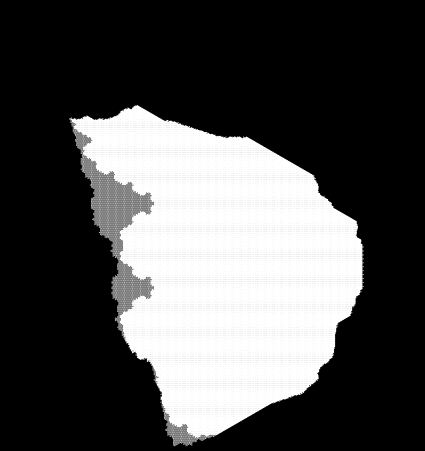Since then I have discovered two techniques which work properly. More broadly than cellular automata, these 'Minkowski lattices' would be useful ways to order data in any simulation that is relativistic, and probably serve as good 'toy' models for quantum field theory or dynamics such as gas models under special relativity. Existing gas models typically have Lorents invariance emerging at large scales, in fact many sites imply that Lorentz invariance is impossible on lattices.
This is somewhat intuitive as a continued Lorentz boost will squash lattice points unendingly down one diagonal axis, so one might expect any lattice to become irrevoquably squashed in this lattice and so cannot maintain its finite point separation. However, as this clip shows, it is in fact possible:
Though I am mainly interested in 3+1 space-time rather than this 1+1 example..
The main trick is to ensure that no lattice points ever touch the light cone (t2 = x2 + y2 + z2), since such points will indeed get bunched up.
The first method comes from this 2010 paper, it provides several possible configurations but the main one has basis lattice vectors (t,x,y,z) as:
(√3,0,0,0)
(0,1,0,0)
(0,0,1,0)
(0,0,0,1)
In fact, all the lattices in this method are the same shape, but with different irrationals for time, the simplest being: √3, √2, √5/3, √6, √4/3, √3/2, √7/5. They are therefore all rectangular lattices, the different time values represent different stages where the lattice returns to its original shape. So, although √4/3 is a more square lattice it has to boost further than the √3 version in order to regain its shape.
The problem with this lattice, which is not made clear in the paper is that, while one can boost this lattice in each of the 3 dimensions separately, it doesn't allow any boost to remain in a bounded gap lattice, for example a boost in the x+y+z direction has events located directly on the light cone, so these will stretch and squash without bounds.
Another technique as highlighted on a John Baez post, uses a compiled list of possible Minkowski lattices, these are encoded as Dynkin diagrams. Of all the rank 4 ones (for our 3+1 space-time) it is interesting that there is only one which is both symmetrisable and compact. I'm not really sure what this means, but compactified Minkowski space is interesting as it adds extra symmetries to the group of Poincare transforms, and is used for example by Roger Penrose in his Road to Reality book. In any case, both conditions sound like they add extra symmetries to this group in one form or another, this Dynkin diagram is labelled sr136 (simply the 136th diagram to be labelled), or H13(4) (the 13th Hyperbolic Dynkin diagram of rank 4).
Calculating the root vectors is not simple, and I had to assume that we use a Minkowski metric (t2 is negative) in the angle calculations. One can either find a set of vectors with angles between them defined by the diagram rules and known relative lengths, or equivalently you can find them by generating the Cartan matrix from the diagram and using each element as the dot product between the two vectors divided by the first vector's square magnitude. It gives basis vectors (for diagram elements 1-4) as:
(0,2,0,0),
(0,-1,1,0),
(0,0,-1,1),
(√7,-1,-1,-3)
Using linear combinations and Lorentz transforms we can simplify this to:
(√3,0,0,0),
(0,1,0,0),
(0,0,1,0),
(√1/12, 1/2, 1/2, √1/2+1/12)
which is very similar to the other method, but apparently has the symmetrisable and compactness properties which would be interesting to investigate. In both cases the sum of the square vector lengths is 0.





























